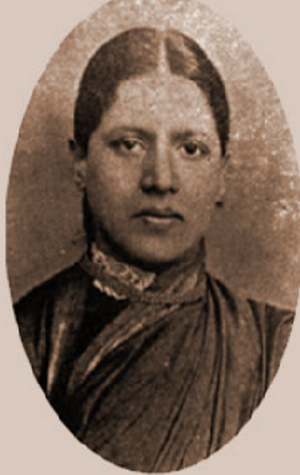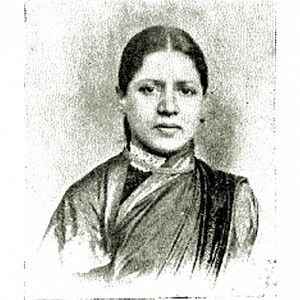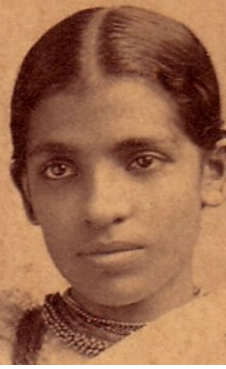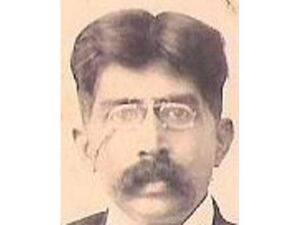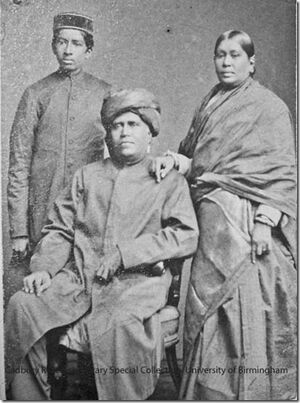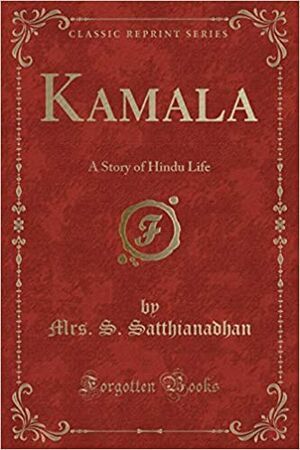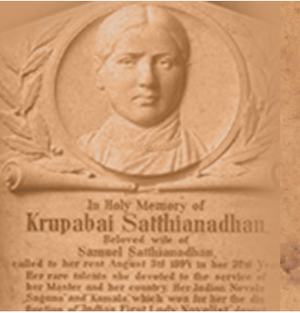Krupa Satthianadhan
இந்தப் பக்கத்தை தமிழில் வாசிக்க: கிருபா சத்தியநாதன்
Krupa Satthianadhan (Krupabai Satthianadhan/Kirubai ) (February 14, 1862 – 1894) was an Indian English writer who portrayed the lives of Tamil women. As her novels were translated into Tamil, Krupabai, thus, gets included in the list of Tamil writers by few researchers. Krupabai authored two novels: Kamala - A Hindu Life and Saguna - A Christian Life. Krupabai is regarded as the writer who portrayed lives of 19th-century women from feminist perspective.
Birth, Education
Krupabai Satthianadhan was born on February 14, 1862 in Ahmednagar, (then in) Maharashtra, to Haripant Khisti and Radhabai. Both her parents were born in the Brahmin community but converted themselves to Christianity.
Bhaskar, Krupabai’s brother introduced her to literature and books. However, Bhaskar passed away at an young age. This created a major void in Krupabai's life. Krupabai characterized Bhaskar as a great personality in her novel Saguna - A Christian Life. As Krupabai was in grief due to Bhaskar's death, two Christian white women comforted her and took responsibility for her education. Krupabai travelled to Mumbai for her studies, met an American female doctor and developed an interest in medicine. Krupabai, being a bright student, moved to Chennai alone at the age of 16 to study medicine at Madras Medical College with scholarships from those two white women. Krupabai joined Madras Medical College in 1878 but, she did not complete her medical course due to tuberculosis issue.
Private Life
At the age of 16, Krupabai moved to Chennai alone to study medicine at Madras Medical College with scholarships from two white women. In Chennai, she stayed with the family of renowned missionary Reverend W. D. Satthianadhan. Krupabai joined Madras Medical College in 1878. She contracted tuberculosis during her medical practice. Krupabai went to her sister’s place in Pune for medical treatment in 1879. Krupabai returned to Chennai and married Satthianadhan’s son Samuel Satthianadhan in 1881. Cambridge educated Samuel relocated to Ooty to serve as the headmaster of Breeks Memorial School. Krupabai shifted to Ooty without completing her medical course and engaged in academic works there. Krupabai started a school for Muslim girls with the help of Church Missionary Society in Ooty.
Krupabai's tuberculosis was under control in Ooty. She penned her early articles and stories from there. Samuel and Krupabai shifted to Rajahmundry after 3 years. Krupabai fell ill again due to the hot environment there. They shifted to Kumbakonam from Rajahmundry. Krupabai continued to write despite her deteriorating health. They returned to Madras in 1886. Krupabai wrote her first novel in Chennai. Saguna - A Christian Life was published in the prestigious Madras Christian College Magazine issued between 1887 and 1888. During this period, Krupabai's only child died before attaining one year of age. This plunged Krupabai into a deep depression. Her tuberculosis also peaked and she then wrote Kamala - A Hindu Life. About her father-in-law and mother-in-law, Krupabai penned two biographical notes. Krupabai died at the age of 31 in 1894. Her novel Kamala - A Hindu Life was published posthumously. In the name of Krupabai Satthianadhan, Madras Medical College instituted a scholarship and University of Madras awards a gold medal to the topper in English.
Literary Life
Krupabai Satthianadhan wrote the novel Kamala - A Hindu Life in 1892 and the novel Saguna - A Christian Life in 1893 in Madras Christian College English magazine which was under the editorship of William Miller, Madras Christian College. These novels were translated into Tamil by the missionary Samuel Paul, who published them in 1896 entitled Kamala – Oru Indhupennin Vazhkai and Saguna - Oru Krusthuvapennin Vazhkai. Saguna - A Christian Life was Krupabai Satthianadhan’s first novel. Kamala - A Hindu Life was the second novel from Krupabai Satthianadhan and she passed away after finishing it. Second novel was published posthumously. Krupabai's novels were widely appreciated at the time of their publications but were forgotten afterwards. After post-colonial scholars Susie Tharu and K. Lalitha cited Krupabai Satthianadhan in their landmark Women Writing in India (1991), her novels were subsequently reprinted.
Literary Significance
Both novels of Krupabai Satthianadhan are biographical in nature. Scholars believe that Saguna - A Christian Life portrays to a large extent her life and, Kamala - A Hindu Life depicts to a large extent her mother's life. While Kamala - A Hindu Life was written contemporarily, it speaks volumes of oppression within conservative family structure, experienced by Krupabai's mother. In these novels, Krupabai portrayed the sufferings of women. Religion conversion was not an easy solution, the converts would lose their own community and face racism of whites who converted them. Krupabai's novels largely deal with these difficulties faced by women.
Scholar Devika says that the white people who wrote the forewords to Krupabai Satthianadhan's novels did not understand these two-sided difficulties in her novels. White people misunderstood that Krupabai was grateful for their services and for accommodating her in Christianity. For Krupabai's posthumous publications, white women always wrote forewords in embracing manner. Mrs. Elisabeth Grigg, a family friend who provided the foreword to Krupabai, considers her remarks about the racial oppression of white Christians to be result of her personal imbalance.[1] Scholars like Priya Joshi, who recently studied the stories of Krupabai Satthianadhan with a feminist perspective, consider Krupabai's view to be not a pro-Christian orientation, but a voice for the emancipation of women against Brahmanical family structure and Christian racism.
Leading Tamil novelists of the day, including A. Madhaviah, were writing in the Chennai Christian College magazine, where Krupabai Satthianadhan wrote the series. In 1892, A. Madhaviah was writing the novel Savitri Charitram in Vivekasindamani magazine based in Chennai. Both these authors' novels have almost same kind of plots over same period of time. These therefore need a comparative study.
Reference
- The Satthianadhan Family Album, by Eunice de Souza
Footnotes
✅Finalised Page
